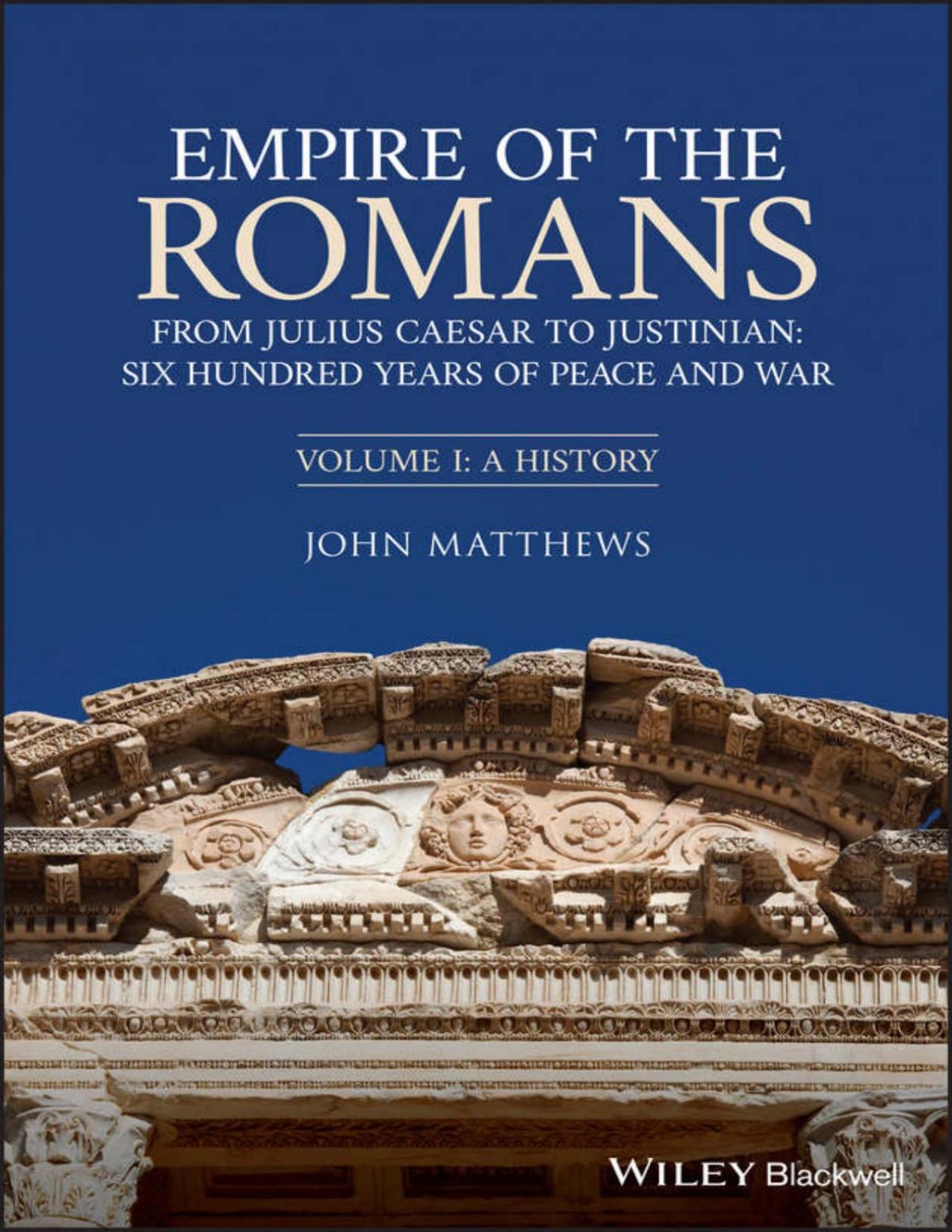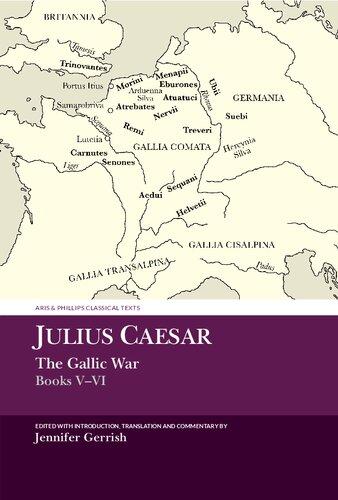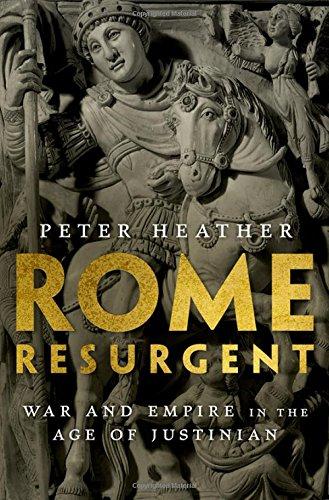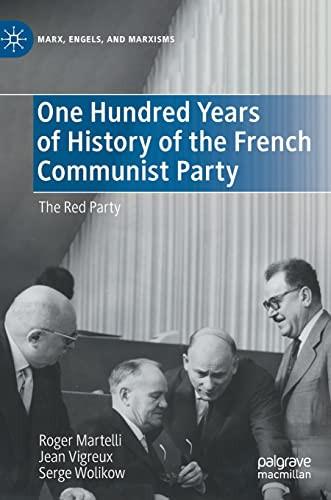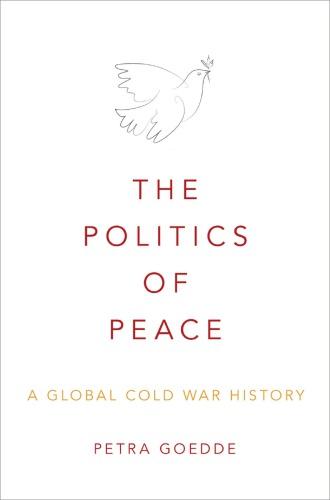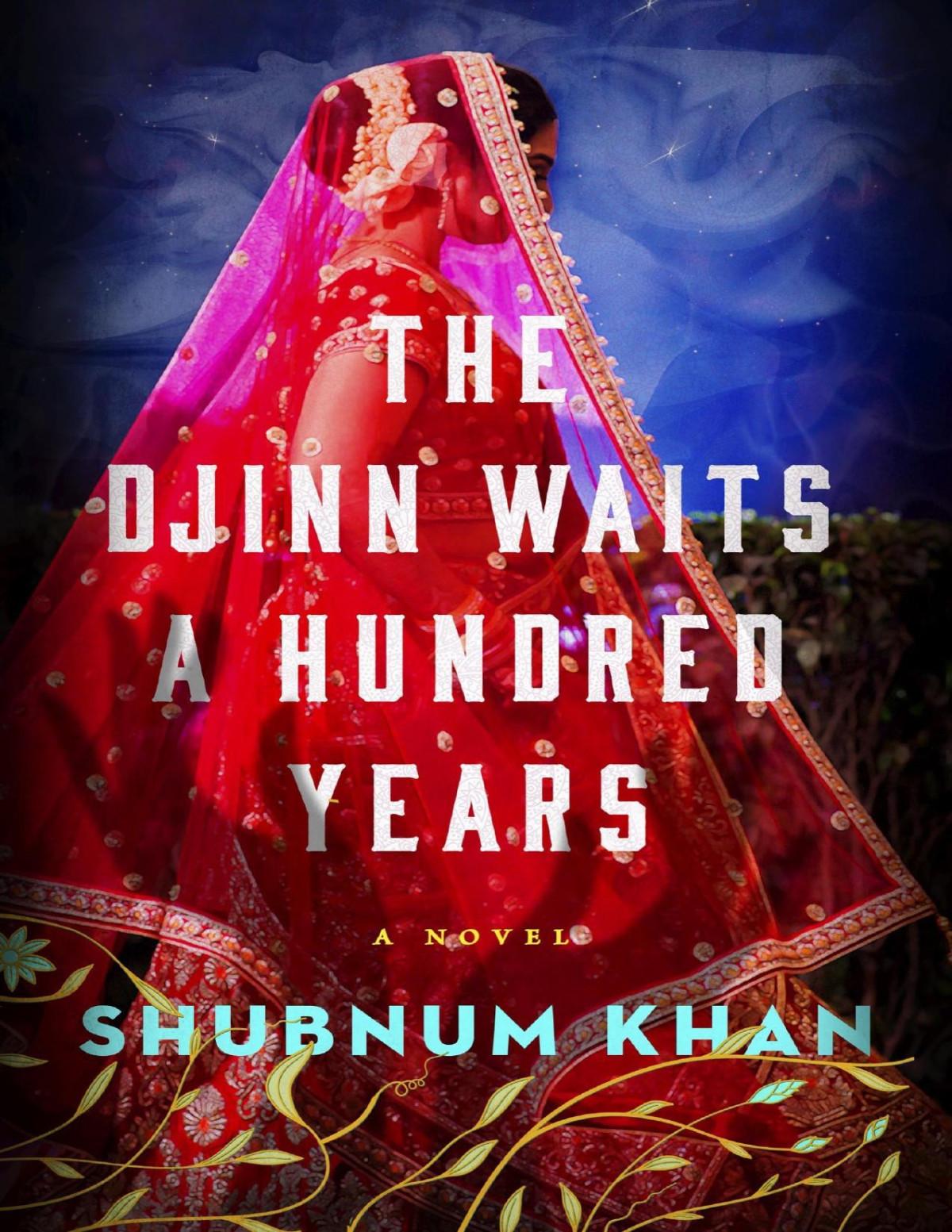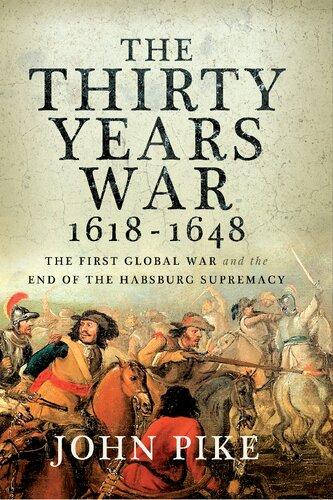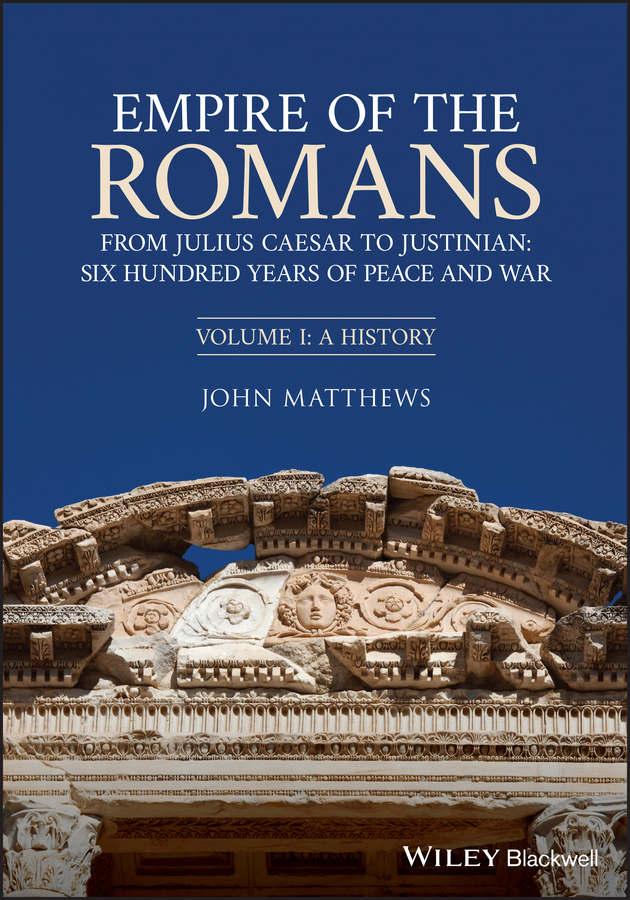Empire of the Romans from Julius Caesar to Justinian: Six Hundred Years of Peace and War, Volume I: A History
John Matthews
Visit to download the full and correct content document: https://ebookmass.com/product/empire-of-the-romans-from-julius-caesar-to-justiniansix-hundred-years-of-peace-and-war-volume-i-a-history-john-matthews/
More products digital (pdf, epub, mobi) instant download maybe you interests ...
Empire of the Romans fro Julius Caesar to Justinian: Six Hundred Years of Peace and War, Volume II: Select Anthology John Matthews
https://ebookmass.com/product/empire-of-the-romans-fro-juliuscaesar-to-justinian-six-hundred-years-of-peace-and-war-volume-iiselect-anthology-john-matthews/
Julius Caesar: The Gallic War Books V-VI Jennifer
Gerrish
https://ebookmass.com/product/julius-caesar-the-gallic-war-booksv-vi-jennifer-gerrish/
Rome Resurgent: War and Empire in the Age of Justinian
Peter Heather https://ebookmass.com/product/rome-resurgent-war-and-empire-inthe-age-of-justinian-peter-heather/
One Hundred Years of History of the French Communist Party Roger Martelli
https://ebookmass.com/product/one-hundred-years-of-history-ofthe-french-communist-party-roger-martelli/
Sextus Julius Frontinus and the Roman Empire John D. Grainger
https://ebookmass.com/product/sextus-julius-frontinus-and-theroman-empire-john-d-grainger/
From slaves to prisoners of war: the Ottoman Empire, Russia, and international law Smiley
https://ebookmass.com/product/from-slaves-to-prisoners-of-warthe-ottoman-empire-russia-and-international-law-smiley/
The Politics Of Peace: A Global Cold War History 1st Edition Edition Petra Goedde
https://ebookmass.com/product/the-politics-of-peace-a-globalcold-war-history-1st-edition-edition-petra-goedde/
The Djinn Waits a Hundred Years: A Novel Shubnum Khan
https://ebookmass.com/product/the-djinn-waits-a-hundred-years-anovel-shubnum-khan/
The Thirty Years War, 1618 - 1648: The First Global War and the end of Habsburg Supremacy John Pike
https://ebookmass.com/product/the-thirty-years-war-1618-1648-thefirst-global-war-and-the-end-of-habsburg-supremacy-john-pike/
Table of Contents
Cover
Title Page
Copyright Page
Preface
List of Maps
List of Figures
Part I: Building an Empire
1 Introduction: The Roman Republic and its Discontents
2 The Tragedy of Julius Caesar
3 Caesar’s Heir
4 A New Order
5 Succession, and the Nature of the Imperial Office
6 The Julio‐Claudian Dynasty: Loyalty and Dissent
Bibliographical Notes to Part I: Building an EmpireBibliographical Notes to Part I: Building an Empire
Chapter 1: The Roman Republic and its Discontents
Chapter 2: The Tragedy of Julius Caesar
Chapter 3: Caesar’s Heir
Chapter 4: The New Order
Chapter 5: Succession, and the Nature of the Imperial Office
Chapter 6: The Julio‐Claudian Dynasty: Loyalty and Dissent
Part II: Pax Romana: “A Polite and Powerful Empire”
7 Frontiers and Provinces
7.1 Wars and Frontiers
7.2 Provinces and Romanisation
8 From Flavians to Severi
9 Age of the Antonines
9.1 Economic Growth and the Sources of Wealth
9.2 The Origins of the Governing Classes
9.3 Literature and Literacy
9.4 Developments in Roman Law
9.5 Health and Mortality
9.6 Epilogue: A “Slow and Secret Poison”?
10 Religious Change and Early Christianity
Bibliographical Notes to Part II: “A Polite and Powerful Empire”Bibliographical Notes to Part II: “A Polite and Powerful Empire”
Chapter 7: Frontiers and Provinces
Chapter 8: From Flavians to Severi
Chapter 9: The Age of the Antonines
Chapter 10: Religious change and early Christianity
Part III: Rising to the Challenge
11 Into an Age of Iron
12 Political Change and the Economy
13 Diocletian and the Tetrarchy
Bibliographical Notes to Part III: Rising to the ChallengeBibliographical Notes to Part III: Rising to the Challenge
Chapter 11: Into an Age of Iron
Chapter 12: Political Change and the Roman Economy
Chapter 13: Diocletian and the Tetrarchy
Part IV: A New Empire
14 The Ascendancy of Constantine
15 Cities of Constantine: Constantinople, Rome, Jerusalem
15.1 Constantinople: A New Capital
15.2 Rome: The Old World
15.3 Jerusalem: A New Ideology
16 The House of Constantine
17 Julian, Hellenism, and Christianity
18 Christianity and Roman Society
19 The Late Roman State
20 Rome and the Barbarian World
Bibliographical Notes to Part IV: A New EmpireBibliographical Notes to Part IV: A New Empire
Chapter 14: The Ascendancy of Constantine
Chapter 15: Cities of Constantine: Constantinople. Rome, Jerusalem
Chapter 16: The House of Constantine
Chapter 17: Julian, Hellenism, and Christianity
Chapter 18: Christianity and Roman Society
Chapter 19: The Late Roman State
Part V: Facing the Future
21 The Fall of Rome
22 Into a Post‐Roman World
23 East and West after the Fall of Rome
24 Royalty at Ravenna
25 Dialogues with the Past: The Reign of Justinian
26 Retrospective
Bibliographical Notes to Part V: Facing the FutureBibliographical Notes to Part V: Facing the Future
Chapter 20: Rome and the Barbarian World
Chapter 21: The Fall of Rome
Chapter 22: Into a Post‐Roman World
Chapter 23: East and West after the Fall of Rome
Chapter 24: Royalty at Ravenna
Chapter 25: Dialogues with the Past: the Reign of Justinian
Chapter 26: Retrospective
Abbreviations and Short Titles
Bibliographical References
References to Part I: Building an Empire
References to Part II: Pax Romana: “A Polite and Powerful Empire”
References to Part III: Rising to the Challenge
References to Part IV: A New Empire
References to Part V: Facing the Future
Index
End User License Agreement
List of Illustrations
Part 1
Map 1.1 The Mediterranean World.
Chapter 1
Figure 1.1 Roman soldiers as builders and laborers: distant descendants of “...
Chapter 4
Map 4.1 The Roman Provinces in 14 CE
Figure 4.1 The late Republican and Augustan forum area.
Figure 4.2 The 13th century obelisk of Sethos I and Rameses II was imported ...
Figure 4.3 The Altar of Augustan Peace: detail of Augustan family.
Figure 4.4 The Augustan and post‐Augustan Campus Martius. For the location o...
Chapter 5
Figure 5.1 The Mausoleum of Augustus in the Campus Martius, as it appeared, ...
Chapter 6
Figure 6.1 Events and policies in the coinage.1–4 The sea‐power of Sextus ...
Figure 6.2 Claudius’ harbor as seen in the Peutinger Map, a thirteenth‐centu...
Chapter 7
Figure 7.1 “Temple to Neptune and Minerva for the well‐being of the sacred i...
Figure 7.2 Maiden Castle, Dorset, (aerial photograph by Major George Allen, ...
Figure 7.3 The “Maison Carrée” in Nemausus (Nîmes) in southern Gaul, seen in...
Figure 7.4 The so‐called “Temple of Janus” (more probably Mars or Celtic equ...
Figure 7.5 The triple “déesses‐mères” (matronae, goddesses of plenty) of Gal...
Figure 7.6 The central feature of the pediment of the temple of Sul‐Minerva ...
Chapter 8
Map 8.1 The Roman Provinces in the Time of Trajan
Figure 8.1 The Rhine‐Danube Frontier under the Flavians and Antonines.
Figure 8.2 a, b Trajan’s Column showing the two Dacian campaigns of Trajan, ...
Figure 8.3 Contemporary portrait of the Severan family, shown in imperial re...
Chapter 9
Figure 9.1 The street plan of Graeco‐Roman Naples as preserved in the modern...
Figure 9.2 The Alcantára bridge over the river Tagus in south‐western Spain ...
Figure 9.3 Scene from a pharmacist’s or general store, in a funerary relief ...
Figure 9.4 Picture of a smithy, in a funerary relief from Aquileia.
Chapter 11
Figure 11.1 Imperial images of the later third and early fourth century as t...
Chapter 12
Figure 12.1 Scene of moneychangers on a funerary relief from Neumagen (Novio...
Chapter 13
Figure 13.1 Tetrarchic Chronology 284–313.
Figure 13.2 The Tetrarchic units styled Ioviani and Herculiani, as they appe...
Figure 13.3 Two of the (presumed) Tetrarchs, portrayed in the sculptured gro...
Chapter 14
Figure 14.1 The east façade of the palace of Diocletian at Split.
Figure 14.2 Chronology of Constantine, 305‐30.
Figure 14.3 (a) Arch of Constantine, north façade. Source: Alto Vintage Imag...
Chapter 15
Figure 15.1 Constantinople in the Peutinger Map, §8a (detail).
Figure 15.2 The Forum of Constantine as shown (East face, register 1) in six...
Figure 15.3 Distribution of churches in fourth‐ and fifth‐century Rome.
Figure 15.4 Old St. Peter’s, threatened by the construction of Michelangelo’...
Figure 15.5 The Madaba map mosaic.
Chapter 16
Figure 16.1 (a) Constantius Augustus and (b) Gallus Caesar, shown as consuls...
Chapter 17
Figure 17.1 Hero of Alexandria, Katoptrika 18.
Chapter 19
Map 19.1 The Roman Provinces from the Severans to Diocletian
Figure 19.1 (a) The insignia of the praetorian prefect of Italy as they appe...
Chapter 20
Figure 20.1 Roman coins in Gothia,, late third to early fifth centuries.
Figure 20.2 A herding community living in peace, as seen in rock drawings in...
Chapter 21
Figure 21.1 Ivory diptych of Theodosius with his wife Serena, daughter of an...
Figure 21.2 “Count of Italy” (comes Italiae) as it appears in the Notitia Di...
Chapter 22
Map 22.1 The Roman World, c. 500
Chapter 23
Figure 23.1 The church of Santa Maria Maggiore at Rome, as seen by Giovanni ...
Chapter 24
Figure 24.1 The personal monograms of Odoacer (left) and Theoderic (right) f...
Figure 24.2 The mausoleum of Theoderic at Ravenna, with the monolithic roof ...
Chapter 25
Figure 25.1 The Hippodrome, as illustrated in the posthumous work De Ludis C...
Figure 25.2 Longitudinal (E./W.) cross‐section of the church of S. Sophia, s...
Figure 25.3 Drawing of an imperial horseman, from a fifteenth‐century manusc...
Figure 25.4 Mosaic of the Empress Theodora in the church of San Vitale at Ra...
Chapter 26
Map 26.1 The Empire of Justinian
VOLUME I A HISTORY
Empire of the Romans
From Julius Caesar to Justinian: Six Hundred Years of Peace and War
JOHN MATTHEWS
This edition first published 2021 © 2021 John F. Matthews
All rights reserved. No part of this publication may be reproduced, stored in a retrieval system, or transmitted, in any form or by any means, electronic, mechanical, photocopying, recording or otherwise, except as permitted by law. Advice on how to obtain permission to reuse material from this title is available at http://www.wiley.com/go/permissions
The right of John Matthews to be identified as the author of this work has been asserted in accordance with law.
Registered Offices
John Wiley & Sons, Inc., 111 River Street, Hoboken, NJ 07030, USA
John Wiley & Sons Ltd, The Atrium, Southern Gate, Chichester, West Sussex, PO19 8SQ, UK
Editorial Office
111 River Street, Hoboken, NJ 07030, USA
For details of our global editorial offices, customer services, and more information about Wiley products visit us at www.wiley.com.
Wiley also publishes its books in a variety of electronic formats and by print‐on‐demand. Some content that appears in standard print versions of this book may not be available in other formats.
Limit of Liability/Disclaimer of Warranty
While the publisher and authors have used their best efforts in preparing this work, they make no representations or warranties with respect to the accuracy or completeness of the contents of this work and specifically disclaim all warranties, including without limitation any implied warranties of merchantability or fitness for a particular purpose. No warranty may be created or extended by sales representatives, written sales materials or promotional statements for this work. The fact that an organization, website, or product is referred to in this work as a citation and/or potential source of further information does not mean that the publisher and authors endorse the information or services the organization, website, or product may provide or recommendations it may make. This work is sold with the understanding that the publisher is not engaged in rendering professional services. The advice and strategies contained herein may not be suitable for your situation. You should consult with a specialist where appropriate. Further, readers should be aware that websites listed in this work may have changed or disappeared between when this work was written and when it is read. Neither the publisher nor authors shall be liable for any loss of profit or any other commercial damages, including but not limited to special, incidental, consequential, or other damages.
Library of Congress Cataloging‐in‐Publication Data
Name: Matthews, John (John Frederick), author.
Title: Empire of the Romans : from Julius Caesar to Justinian: six hundred years of peace and war / John Matthews.
Other titles: From Julius Caesar to Justinian: six hundred years of peace and war
Description: Hoboken, NJ : Wiley‐Blackwell, 2020. | Includes bibliographical references and index.
Identifiers: LCCN 2020026857 (print) | LCCN 2020026858 (ebook) | ISBN 9781444334562 (v.1 ; paperback) | ISBN 9781444334586 (v.2 ; paperback) | ISBN 9781119481546 (v.2 ; adobe pdf) | ISBN 9781119481560 (v.2 ; epub) | ISBN 9781119610311
(v.1 ; adobe pdf) | ISBN 9781119610359 (v.1 ; epub)
Subjects: LCSH: Rome–History–Empire, 30 B.C.‐284 A.D. | Rome–Civilization. | Rome–History–Empire, 30 B.C.‐284 A.D.–Sources. | Rome–Civilization–Sources.
Classification: LCC DG270 .M364 2020 (print) | LCC DG270 (ebook) | DDC 937/.06–dc23
LC record available at https://lccn.loc.gov/2020026857
LC ebook record available at https://lccn.loc.gov/2020026858
Cover Design: Wiley
Cover Image: © Nigel Hicks/Getty Images
Preface
The appearance of yet another book on the Roman empire invites a few words of explanation. Many good books exist already, and keep appearing – rightly so, for it is a very good subject, and an important one. The history of Rome makes up a substantial portion of the history of western culture, and its linguistic, cultural, and legal influences persist. The span of time from the legendary foundation of Rome in 753 BCE to the death of the emperor Justinian in 565 CE is not far short of that from the death of Justinian to the present day, an observation that has still more in its favour if one takes the date of the first Olympic Games in 776 BCE as the beginning of Greek, and so of Graeco‐Roman history (admittedly they took some time to converge). In some ways, this is a still more appropriate moment of definition, for it also marks the period of time in which the Greeks adopted the system of writing, the origin of our own, that would enable them to record their own history and in due course that of the Romans, under whom many of their finest writers lived. This book takes as its starting point an event that is as much a part of Greek as of Roman history, as recorded by a Greek author writing under the Roman empire, and moves on to the analyses offered by an earlier Greek historian on the Romans who were coming to dominate his world; and it ends with the descriptions given by the last Classical Greek historian, of Justinian’s attempts to restore that Roman world as it had once been. The Romans had their own historians, and their own ways of writing, but it is significant that a history of the Roman empire can be framed by the writings of Greek observers of it. The Greeks were there first and they were around for longer.
The Roman empire is also a time of which we have substantial knowledge – not such as to stand comparison with the mountains of documentation for the history of the modern world, but nevertheless incorporating evidence of many different sorts, physical as well as literate, permitting the re‐creation of a world of great sophistication and variety. It is a world that encourages different conceptions among those who write about it and their public; and that this public
ranges far beyond the academic is evident from published lists of current and new books.
One may still ask what are the points of difference that mark a new book on such a well‐established subject. The first question, which faces the historian of any period, is that of range; where will it begin and end? As to the former, we should take for granted that any book on the Roman empire will acknowledge the political and social antecedents of the Republican period. We must however be careful. The end of nearly half a millennium of “Republican” government in the first century BCE does not signal the end of “res publica” in its broader sense; that array of political, social and legal institutions that belonged to the domain of public authority. However breached in the observance, the distinction between public authority and private power was one insisted upon by the founder of imperial government, after the end of the civil wars that destroyed the Republic. Augustus and his successors may have expressed themselves differently as to what they had done with “res publica,” but none of them would have claimed its abolition. As late as 533, in publishing his Digest of Roman law, Justinian referred to the emperor’s duty, whenever an unexpected contingency might arise not covered by law, “to correct and settle it and to subject it to suitable procedures and regulations,” citing in support a famous jurist of the early second century. There were “tyrannical” emperors, but the Roman empire was not a tyranny.
Whether a continuation of “res publica” in this broader sense was the only possible framework for a solution to the problems of the late Republic is an interesting question, but it was the solution that was adopted, and I have taken it to justify an introductory chapter on the political difficulties of the last two centuries BCE. There will be little here to surprise readers familiar with the history of the late Republic. Nor have I tried to invent surprises, but a book on the Roman empire would be incomplete without such an introduction to the system that it replaced.
If all presentations of the Roman empire will share an interest in the history of the Republic, there is more diversity to be found in their terminal points. How, when, and in what circumstances did the Roman empire come to an end? This is a very large question and it
will cause no surprise to find a variety of answers to it; a process of disintegration will always be less orderly than a process of growth. It will be harder to describe and will invite different points of emphasis, as the ancient sources themselves lose their sense of direction, and modern writers take different views as to what point the disintegration has reached, and whether what is left should count as Roman. There are also more prosaic reasons; I have heard of cases where a lecture course has come to an end simply because time has run out on the lecturer, as if the Roman world had declined and fallen for the convenience of the syllabus.
Choices have to be made, but it is still worth noticing how the terminal point of a history may imply a judgment as to what is important. The decision to end a book on the Roman empire with the beginnings of Diocletian’s Tetrarchy in the 280s may invite us to conclude that what follows is part of a different, late Roman or even early medieval story (and medieval histories do often begin at this point). It is true that what follows in the fourth century shows important differences from what precedes – including a vastly increased scale of documentation on a far wider range of issues. Yet, it is not too much to say that the outcome of a generation’s research on the later Roman period has been to show how the empire of the fourth century was more Classical than Medieval. Neither Ammianus Marcellinus nor Claudian nor Procopius (nor indeed Jerome or Augustine) was a medieval writer, the Theodosian Code was a book of Roman law, while those political and social changes that make the later period seem so different from the earlier may also be understood as conditions for the survival of the Roman world and its culture.
A book that ended with the death of Constantine in 337 might ask us to believe that a Christian empire is so at odds with the story of Classical Rome as to require separate consideration, a choice that sets aside the fascinating story of how the Classical and Christian elements in Constantine’s empire responded to each other. To proceed further, a terminal point of 395 will reflect the idea that an empire divided between eastern and western governments is a new situation requiring a new treatment, but this does less than justice to the elements of an east‐west distinction in the Roman empire that had long existed and, in the second century, had proved immensely
fertile before it ever became a burden. Byzantine history has very deep roots in the Classical world. The Sack of Rome of 410, and the deposition of the last Roman emperor in 476 again offer defensible terminal points, based in these cases upon events of symbolic rather than substantive value; so too the execution of the Roman Boethius by Theoderic the Ostrogoth. These are all moments to stop for reflection and for wondering what may be the shape of things to come.
This book goes beyond all of them to end with the death of Justinian in 565, recognising both that emperor’s determination to restore the empire of the past, and the work of the last truly Classical historian, Procopius of Caesarea, in documenting the failure of the attempt. A good case could be made for continuing to the first Arab conquests in the Byzantine domains in the early seventh century, but at some point one has to leave it to someone else to carry on. The sensitivities and techniques of the Classical historian are durable but they do not last for ever, and one’s sense of the declining force of familiar methods of analysis is not a bad guide to the moment when the Classical world has ended.
Novelists sometimes remark that, once imagined, characters in a novel will choose for themselves what they do, what will happen to them and how they will respond to it. In an odd sort of way (since his characters’ futures are already in the past), the same is true of the historian. Though without a novelist’s freedom, the historian will have imagined his story in a certain way and its characters will have chosen what will happen to them. Having found its logic, a book will tend to carry on as it has started: which is to say that its character will have become ingrained quite early in the process of composition. It will also reflect a number of more personal and subjective considerations, first among which is the nature of a historian’s own past research, which will have provided familiarity with certain fields of study and types of source rather than others, and a corresponding sense of what is important. I have done my best to allow for these differences, but they will show. Style and manner are also a personal matter on which judgments have to be made; how to balance the detail with the flow of the narrative, the individual experience with the great movement; how to integrate narrative and digression; what level of detail is appropriate; how far to pursue the sub‐plot.
Excessive detail without context is tedious, but so, in my experience, are even the most profound generalities if they lack focus on the particular.
I have attempted to tell the story continuously, and to follow its changing features through transitions and across turning‐points that might otherwise divide it; what may at first appear as a challenge to the Roman empire may in the end turn out to be what allows it to carry on. The Romans measured their history in centuries – the time of Augustus is as remote from that of Justinian as the Wars of the Roses are from us, and those wars were already a century old when Shakespeare wrote of the last of them – and they had a strong sense of an evolving history emerging from the past. It is a moment of surprise when Ammianus Marcellinus refers to Domitian and to the figure whom he styles Octavianus Augustus, as emperors “of olden times”, until one realizes that he is looking back three and four hundred years from his own day.
The story unfolds through an interplay of narrative and digression; history is not timeless, and whatever the importance of the broader socio‐economic and cultural issues at stake and with whatever success they have been described, we do need to know where we are. The combination of approaches is accommodated in a rather large number of relatively compact chapters, grouped in sections to help bring out the shape of the argument as it moves forward. Yet this is not, considering its subject, an especially long book, and there has at all points been a question of selection with its surly companion, the omission of things that should have been included. I have often realized, in reading through drafts of its later chapters, that something should have been said earlier about topics that arise in them. There is a sense in which, in a society sufficiently conscious of its past to want to write about it, all history is concurrent, running together in the memory. The whole thing is in the mind together, and one of the skills that the historian has to learn is how to present concurrent issues in sequence; to have them appear at the right moment. As Edward Gibbon understood, the future problems of the Roman empire can already be seen in the Golden Age of the second century. It is only in a Hollywood movie that one would actually put its fall in that period, but it is still appropriate, if it can be done without distraction, to mention at the moment of their earlier
appearances, matters that will become important later. It was Tacitus’ habit to characterize upon their first appearance figures who would become important later in his history, a practice that certainly helps to sharpen one’s expectations of the future.
Finally, I have tried to give a sense of the primary material on which the story is based, and for this I need to say a few words about the companion volume of this book. Volume Two: Select Anthology offers a complementary selection of texts running in parallel with the main divisions of the present volume, chosen also to broaden its range, and able, with its introductions and commentaries, to be used as a free‐standing work. It will sometimes document something said in the present Volume, but more often will offer a broader, sometimes more subjective impression, or offer a shift of viewpoint, as, one might say, from the makers of history to the users of it. I try in the Anthology to balance texts of different types – literary authors with documentary, legal and epigraphic materials, papyrus records, letters and so on – with a special interest in texts that express themselves in the first person or reflect individual experiences. I pay relatively little attention to standard historians such as Tacitus or Suetonius or Ammianus Marcellinus, not because I do not respect these writers (a 600‐page book on one of them should be sufficient proof of that) but because they are available in inexpensive modern translations with excellent introductions, and also because once an ancient historian gets at his material he is no longer a primary source in the strict sense, but an observer with an opinion. I have chosen extracts from historians only when they have some personal or other particular relationship to the events they describe.
I do not want readers coming to the Roman empire, especially if it is for the first time, to be overawed by the panoply of learning that has been devoted to it. It is however important to respect the evidential materials on which our understanding is based. My practice has been to refer in the text to an ancient writer who is directly addressed in it; there is no need to send a reader scurrying off into footnotes to track down a simple reference that can be given in the text without disturbing the appearance of the page. I have similarly added a cross‐reference to Volume Two when a relevant text appears there with its own commentary. I have also, in a series of chapter‐by‐chapter bibliographical essays, given more detailed documentation, with
indications of the modern writing that I have appreciated. These essays have two aims: to give support to statements not directly documented in the text and more generally to help explain why I say what I do; and to guide the reader to the further literature that may be found interesting. I am aware of treading a fine line between the first of these aims (for which they are certainly too little) and the second (for which they are probably too much). There is nothing easier in historical writing than to pile up bibliographies. All I can do is to share my sense of admiration when I read publishers’ lists, or reviews of recent books, or talk with colleagues, or stroll among the shelves of a Classical library, and realise how much there is to know. I apologise to those colleagues whose work I should have mentioned but have not, either because I am not as familiar with it as I should be or have found no occasion to do so when I should have done, while assuring them that I do know what it feels like to be neglected. I am also familiar with books and articles that cite one’s own work without any indication that they are actually familiar with it – the ecology of footnotes is a submarine realm, in which ideas may survive and pass on their genes without ever appearing in the upper world. This book is an introduction to its subject, and I shall be content if it leads readers to the current research that opens new perspectives and novel approaches to what had been thought familiar or was lesser known. It is not a book about network theory, or demography, or climate or disease, though I am full of admiration for the work that is being done in these and other areas, and appreciate that a synthesis of the results of this work, if it is ever made, may produce a Roman empire that looks very different from the one we understand at present.
The Bibliographies to both volumes, it will be noticed, are almost entirely composed of works in English. The primary reason for this is of course their intended public; the last thing the reader wants is to be blown out of the water by a cannonade of writing in languages with which he or she may be unfamiliar. It must also be said that for a book with such a chronological and topical range as this one it would be bordering on insanity to review everything covered in it, in every language in which a topic has been covered. My own teacher Peter Brown commented in 1967 on published bibliographies on St. Augustine, respectively of 988 and (annually) 400 titles (Augustine
of Hippo, p. 10 n. 1). One only has to project these figures to the Roman empire as a whole in all its fields, to see how impossible it would be to cover everything that has been written on it.
I would add a note of recommendation to a form of scholarly literature that the reader will notice in the bibliographical essays; the multi‐authored Companions and Handbooks on selected themes that have appeared from various publishers over recent years: to mention only what comes to mind, there are Companions or Handbooks to the Roman Empire itself and to Greek and Roman Historiography, Greek and Roman Coinage, Roman Britain, the Age of Constantine, Saint Augustine, the Age of Attila (a disconcerting title, but a very useful book), the Age of Justinian. On a more modest scale and each by a single author, there are surveys of the literary sources for Greek and Roman history, Roman law, the uses of papyri, the coinage and epigraphic evidence. Well‐organised and edited, and with well‐chosen authors and contributors, these books are extremely useful in conveying a sense of the present state of a subject, especially for those who like their historical reading to reflect the diverse interests and styles of the writers who contribute to it.
In a fortunate academic career, I have been able to pursue research and teaching as related activities in two great universities, Oxford and Yale, and I extend my sincerest thanks to both of them. It was an early part of my good fortune that I came to know the giants of the profession, A.H.M. Jones, Arnaldo Momigliano, G.E.M. de Ste Croix, E.A. Thompson, Moses Finley, Fergus Millar, Alan Cameron and Averil Cameron, Cyril and Marlia Mango, and of course Ronald Syme and my research supervisor, Peter Brown; not to mention Ramsay MacMullen, for whom my admiration joins with the affection of a personal friendship formed since I came to Yale in 1996. The passing of time has a way of compacting the generations, and among my own contemporaries I would mention my dear friend Peter Garnsey (with a memorable story about his own first meeting with A.H.M. Jones), Roger Tomlin, Timothy Barnes, John Curran, Sabine MacCormack, Patrick Wormald, Bryan Ward‐Perkins, Ian Wood, Michael Whitby and Mary Whitby, William Metcalf and my successor at Yale, Noel Lenski. Among my own research students, now my colleagues, the work of Jill Harries, David Hunt, Ray Davis, Jairus Banaji, Brian Croke, Susanna Elm, Richard Burgess, Peter Heather, Sam Barnish,
Neil McLynn, Polymnia Athanassiadi, David Potter, Edward Watts, Scott McGill, Josiah Osgood, Cristiana Sogno has left an abiding impression. Of my undergraduate students over the years, let Philip Rogerson, Neil Tunnicliffe, Roger Batty and his elder brother Martin, Richard Stoneman, Justin Goddard, Judith Rice, Caroline Mann, Sudhakar Nuti, Wendy Valleau and Amalia Skilton accept my thanks on behalf of all whose work I have appreciated, and my apologies for those whom I have failed to mention.
Authors are as familiar with the patience of publishers as publishers are with the explanations of delay offered by authors, but there is common ground if the purpose is to improve the result. In this case I offer my sincere thanks to Haze Humbert and her colleagues and successors at Messrs John Wiley for responding to my proposal of a history of the Roman empire in this format, for continuing to support it and for helping me through its intricacies, and to Mary Malin and Katherine Carr for editing; and also the scholars in various countries who were consulted and offered their suggestions. To these colleagues, for the learning, experience and collaborative friendship that they have offered, I am most grateful.
My debt to my beloved and gifted wife, Veronika Grimm, is an altogether special one, impossible to express or repay. Her desire that I should get this book finished through all its obstacles (including my own doubts) has been a miraculous combination of the sympathetic and the unrelenting. It is dedicated to her, to her son and daughter, David and Vanessa, to my daughter Helen and in loving memory of her younger sister Julia.
John Matthews, New Haven, Connecticut June 2020
List of Maps
Map 1.1 The Mediterranean World
Map 4.1 The Roman Provinces in 14 CE
Map 8.1 The Roman Provinces in the Time of Trajan
Map 19.1 The Roman Provinces from the Severans to Diocletian
Map 22.1 The Roman World, c. 500
Map 26.1 The Empire of Justinian
List of Figures
Figure 1.1
Roman soldiers as builders and laborers: “Marius’ mules” on Trajan’s column.
Figure 4.1 The late Republican and Augustan forum area.
Figure 4.2 Piazza del Popolo, Rome: obelisk of Sethos I and Rameses II.
Figure 4.3 Altar of Augustan Peace: detail of Augustan family.
Figure 4.4
Figure 5.1
Figure 6.1
The Augustan and post‐Augustan Campus Martius.
The mausoleum of Augustus in the Campus Martius.
Events and policies in the Roman coinage.
Figure 6.2 Ostia and Rome in the Peutinger Map.
Figure 7.1
Dedicatory inscription of temple to Neptune and Minerva, Chichester.
Figure 7.2 Maiden Castle, Dorset.
Figure 7.3 Temple of Rome and Augustus (Maison Carrée), Nîmes.
Figure 7.4
Figure 7.5
Figure 7.6
Temple of Janus, at Autun.
The triple “déesses‐mères” (matronae) in a relief from central Gaul.
Image of Medusa from pediment of the temple of Sulis‐Minerva, Bath.
Figure 8.1 The Rhine‐Danube Frontier under Flavians and Antonines.
Figure 8.2
Figure 8.3
Scenes from the Dacian Wars on Trajan’s column, Rome.
Septimius Severus, Julia Domna and their sons in the Berlin tondo.
Figure 9.1 Naples, aerial view.
Figure 9.2
Figure 9.3
Figure 9.4
Figure 11.1
Figure 12.1
Figure 13.1
Figure 13.2
Bridge over the Tagus river at Alcantára, south‐western Spain.
Scene from a pharmacist’s or general store: funerary relief from Juliobona, northern Gaul.
Blacksmith and apprentice at work: funerary relief from Aquileia.
The imperial image in the coinage, later third to early fourth century.
Scene of moneychangers: funerary relief from Neumagen.
Tetrarchic Chronology 284–313.
Ioviani and Herculiani in the Notitia Dignitatum.
Figure 13.3 The “Venice Tetrarchs”, S. Marco, Venice.
Figure 14.1
Figure 14.2
Figure 14.3
Figure 15.1
Figure 15.2
Figure 15.3
Diocletian’s palace, Split, east façade.
Chronology of Constantine, 305–30.
Arch of Constantine, Rome, north façade.
Constantinople in the Peutinger Map.
The Forum of Constantine on the Column of Arcadius.
Churches in fourth‐ and fifth‐century Rome.
Figure 15.4
Figure 15.5
Figure 16.1
Figure 17.1
Figure 19.1
Figure 20.1
Figure 20.2
Figure 21.1
Figure 21.2
Figure 23.1
Figure 24.1
Figure 24.2
Figure 25.1
Figure 25.2
Figure 25.3
Figure 25.4
Old and New St. Peter’s: drawing by Giovanantonio Dosio, c. 1574.
The City of Jerusalem in the Madaba Map (Jordan).
Constantius and Gallus.
Mirror visions: Hero of Alexandria, Katoptrika 18.
Late Roman Insignia in the Notitia Dignitatum.
Roman coins in Gothia, late third to early fifth centuries.
A herding community living in southern Russia.
Ivory diptych of Stilicho, Serena, and Eucherius.
The comes Italiae in the Notitia Dignitatum.
The church of Santa Maria Maggiore, Rome.
The personal monograms of Odoacer and Theoderic.
The mausoleum of Theoderic at Ravenna.
The Hippodrome at Constantinople.
Longitudinal cross‐section of the church of S. Sophia at Constantinople.
Manuscript drawing of late imperial horseman.
Mosaic portrait of Theodora, church of San Vitale, Ravenna.
